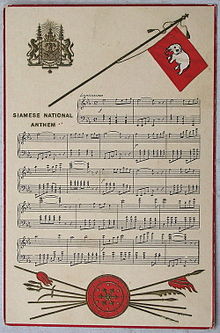Phleng Sansoen Phra Barami
Phleng Sansoen Phra Barami or Phleng Sanrasoen Phra Barami (both variants are permitted and are spelled the same in Thai script : เพลง สรรเสริญ พระ บารมี , pronunciation: [pʰleːŋ sǎnsɤ̌ːn] or [sǎnrásɤ̌ːn pʰráʔ baːrámiː] , roughly translated: "Hymn in praise of the king" ) is the royal anthem of Thailand . The melody comes from the Russian composer Pyotr Andreevich Schchurowski ( Пётр Андреевич Щуровский , 1850–1908). Prince Narisara Nuwattiwong wrote the accompanying text, but it was revised by King Vajiravudh (Rama VI) around 1913 . Phleng Sansoen Phra Barami also served as the national anthem of Siam until the end of the absolute monarchy in 1932 , but was then replaced by Phleng Chat , today's national anthem of Thailand.
| Thai | Transcription ( RTGS ) |
|---|---|
| ข้าว ร พุทธ เจ้า | Kha wora Phutthachao |
| เอา มโน และ ศิร กราน | Ao mano lae sira crane |
| น บ พระภูมิ บาล บุญ ญะ ดิเรก | Nop phra phummiban bunyadirek |
| เอก บรม จักริน | Ek borommachakkrin |
| พระ ส ยา มิ นท ร์ | Phra sayamin |
| พระ ยศ ยิ่ง ยง | Phra yotsa ying yong |
| เย็น ศิระ เพราะ พระ บริบาล | Yen sira phro phra boriban |
| ผล พระคุณ ธ รักษา | Phon phra khun tha raksa |
| ปวง ประชา เป็น ศุ ข สาน ต์ | Puang phracha pen sukkhasan |
| ขอ บันดาล | Kho bandan |
| ธ ประสงค์ ใด | Tha prasong dai |
| จง ส ฤ ษ ดิ์ | Chong sarit |
| ดัง หวัง วร หฤทัย | Dang wang wara haruethai |
| ดุจ จะ ถวาย ชัย ชโย! | Dut cha thawai chai chayo |
The text is written in a very high linguistic register , the rachasap ("royal language"). The vocabulary used consists largely of foreign words and loan words from the Pali . A literal translation is therefore practically impossible. The following is just an approximation:
I, Servant of His Majesty, place my heart and body at his feet to
show him respect and praise
the protector of the land,
the great Chakri dynasty,
the mighty and splendid leader of the Siamese people,
the people in peace and contentment
through his tireless leadership.
Please, whatever his pleasure
may be done for his credit.
The royal anthem is played in Thailand when a member of the House of Chakri performs on an official mission. The anthem is also heard at the beginning and at the end of the programs of various television stations, as well as before the start of the main film in all Thai cinemas, whereby the audience has to rise. It is then usually accompanied by images from the life of the long-time King Bhumibol Adulyadej (Rama IX). While standing while the hymn is playing is only a customary practice and not a legal requirement, an investigation into lese majesty was launched in April 2008 against two social activists after they refused to do so.
See also
Web links
- สรรเสริญ พระ บารมี - Several sound samples on the Thai Wikipedia page
Individual evidence
- ↑ Щуровский, Пётр Андреевич ( Shchurovsky, Pyotr Andreevich ). In: Kurskaja Enziklopedija (online version), accessed on June 2, 2015.
- ↑ Sukri Charoensuk ( สุ กรี เจริญสุข ): 99 ปี เพลง สรรเสริญ พระ บารมี [99 Pi Phleng Sansoen Phra Barami; 99 years of Phleng Sansoen Phra Barami]. Bansomdejchaopraya University of Education, Bangkok 1987, ISBN 974-7443-27-9 , p. 82.
- ↑ Nicholas Grossman, Dominic Faulder (ed.): King Bhumibol Adulyadej - A Life's Work. Thailand's Monarchy in Perspective . Editions Didier Millet, Singapore 2012, ISBN 978-981-4260-56-5 , p. 359
- ↑ Thailand. In: Country Reports on Human Rights Practices for 2008. Volume 1, US Department of State, Washington DC 2008, p. 1018.
- ↑ Thai couple faces lèse majesté charges for not standing for royal anthem in cinema. In: Prachatai , April 9, 2008.
